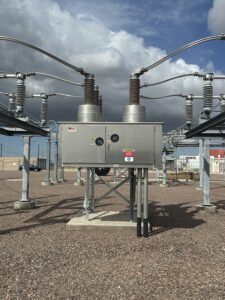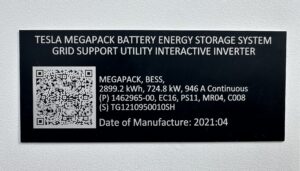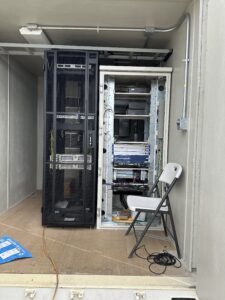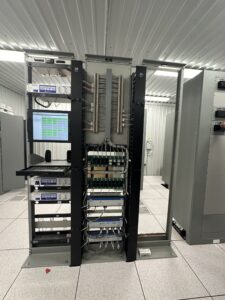Tesla Batteries
Moksha D -
Hi everyone and welcome back to my blog!
This week I had the privilege of seeing lithium-ion batteries in person and to many people’s interest, they were Tesla batteries.
Tesla not only makes batteries for cars, but also batteries for utility companies like Salt River Project, SRP. SRP purchases some of their lithium-ion batteries from Tesla as storage units for solar energy. These units are known as megapacks.
Pictured below is a 12kv feeder which goes to 4 way switches. The switches have different configurations that communicate to transformers in different ways allowing them to stay on or off.

Each transformer is associated with a Tesla megapack (a lithium-ion battery for storage) which is pictured below.

The megapacks have labels which describe the voltage and current that it has. Below is an example of what a label looks like.

The 2899.2kWh means that it can discharge power for about 4 hours considering it has 724.8kw. Each megapack can have a different kWh.
Underneath the megapacks, are cooling units to ensure they stay at a consistent temperature so it does not catch on fire. Other safety features include keeping the megapacks at least 6 inches apart and then each unit around 14 feet apart.
In case a pack catches on fire, it will stay contained to one pack and not destroy all of them. The fronts of the packs face opposite ways to uphold these regulations as well. Space is a huge safety feature when dealing with batteries.
Seen below is the configuration they keep the Tesla megapacks in to ensure a fire will not penetrate more than one.

Luckily in Arizona, because of how much space we have, it is relatively easy to keep these megapacks at a good distance from each other. If they are all confined to one building, it is very difficult to prevent a fire from spreading.
Because these are in packs, if one catches on fire, there is a guarantee that there is no human inside whereas when batteries are kept in a building where engineers could be researching, there is a lot of potential energy stored in one place. If something catches on fire, when a firefighter opens the door and the air mixes, this can cause explosions which are catastrophic for both the batteries and the people inside.
Pictured below is where all the information about these battery packs is fed.

This information then goes to a control room pictured below where the engineers can see the condition of each pack and whether they are on or off or if there are any problems with them.

As you can see, all the boxes on the computer are green meaning all the packs were in good condition at the time.
Next week, I will talk more about the efficiency of these packs, safety features, and public perception. Thank you for reading!

Comments:
All viewpoints are welcome but profane, threatening, disrespectful, or harassing comments will not be tolerated and are subject to moderation up to, and including, full deletion.